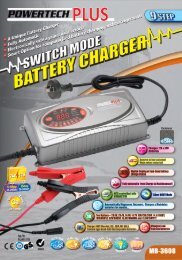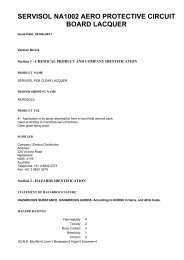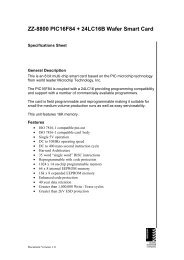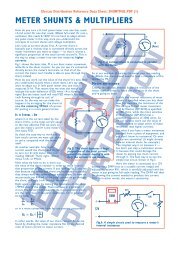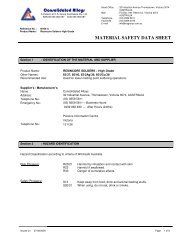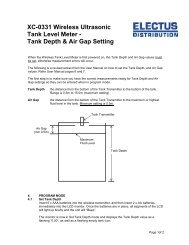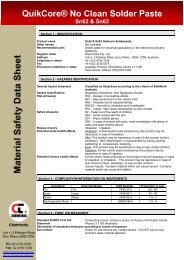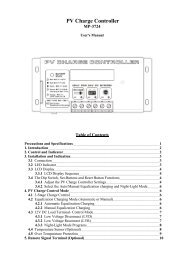SIMMs & OTHER MEMORY MODULES - Electus Distribution
SIMMs & OTHER MEMORY MODULES - Electus Distribution
SIMMs & OTHER MEMORY MODULES - Electus Distribution
- No tags were found...
You also want an ePaper? Increase the reach of your titles
YUMPU automatically turns print PDFs into web optimized ePapers that Google loves.
In early generations of personal computer, thecomputer’s RAM (random access, or read-writememory) was in the form of groups or ‘banks’ ofstandard DIL (dual-in-line) IC chips that were eithersoldered directly to the mother board or plugged intosockets on it. However as later computers began toneed more and more memory, plug-in modules weredeveloped as convenient replacements for this ‘chiplevel’ memory.Most modern PCs are designed to have their memory inthe form of these plug-in memory modules. The samemodules are also used to expand the memory insidelaser printers, etc. However it’s easy to get confused,because there are now both a number of different typesof module, and also many different kinds of memorychip used in them.In this data sheet we’ll try to give you a good basicunderstanding of memory modules and the technologyin them, so you’ll hopefully be able to pick the rightmodule for your application. We’ll look at the maintypes of memory module, in roughly the order theywere developed. But first, let’s clarify a few generalterms you’ll come across in connection with computermemory.Bits and bytesYou’re probably already aware that inside a computerthe information is handled entirely in 1’s and 0’s — i.e.,in binary digits, or bits. One bit is the smallest possibleamount of information, and can only have a value ofeither 1 or 0.To handle appreciable amounts of information efficiently,computers don’t try to handle every bit individually.Instead they group them into 8-bit ‘parcels’ known asbytes. The first PCs (and many microcontrollers) did allof their arithmetic and data manipulation with these8-bit bytes, and are therefore called ‘8 bit’ computers.Later PCs like the 80286-based ‘AT’ models handled two8-bit bytes at the same time, and are not surprisinglycalled ‘16-bit’ computers.When 486-based PCs came along, these manipulated thedata in four-byte words, and are thus described as‘32-bit’ computers.And lastly (for the present) there are theeven newer Pentium/PII/PIII class computers,which manipulate the data in 8-byte words orlarger. These are therefore described as‘64-bit’ or ‘128-bit’ computers, as the casemay be.Kilobytes & megabytesBecause modern computer memories aredesigned to store very large amounts of data,their storage capacity is usually given in termsof kilobytes or megabytes — same termsused to describe the capacity of floppy disksand hard disk drives, etc. But remember thatin computer parlance, the prefixes ‘kilo’ and‘mega’ are the binary versions, not thedecimal variety.So a kilobyte is 1024 bytes, not 1000.Similarly a megabyte is 1024 kilobytes, or1,048,576 bytes. It’s good practice to use ‘KB’and ‘MB’ to represent kilobytes andmegabytes respectively, as a reminder thatwe’re using the binary multipliers and also<strong>Electus</strong> <strong>Distribution</strong> Reference Data Sheet: SIMMS.PDF (1)<strong>SIMMs</strong> & <strong>OTHER</strong> <strong>MEMORY</strong> <strong>MODULES</strong>talking about bytes rather than individual bits.SRAM, DRAM and ROMStrictly speaking all memory used in modern computersis random-access memory or ‘RAM’, meaning that thedata in any particular memory location or cell is just asaccessible as any other data, merely by specifying itsunique ‘memory address’. However by convention theterm ‘RAM’ is only used to signify read-write randomaccess memory, where data can be either written to orread from any address at random.This is mainly to distinguish read-write memory fromread-only memory or ‘ROM’, where the data can onlybe written to (i.e., stored in) each location once, andfrom then on only read out when it’s needed. ROMs arestill randomly accessible, of course.As it happens there are also two main types of RAMchip: the static RAM or SRAM, and the dynamic RAM orDRAM.SRAMs are essentially arrays of transistor flip-flops, eachof which can store one bit of information indefinitely aslong as the chip is supplied with power. Because of theircomplexity SRAMs are fairly expensive, but they’re alsocapable of the fastest operation. That’s why they’re usedin a computer’s cache memory — the relatively smallbut very fast ‘scratchpad’ memory used to providefrequently-needed information to the CPU much fasterthan the main memory can supply it.In contrast, the memory cells in DRAMs are little morethan tiny MOS storage capacitors, where the bits arestored as the presence or absence of electrical charge.This makes DRAMs much cheaper memory than SRAMs,but because the charges tend to ‘leak away’ after a shorttime, the data in a DRAM must be regularly ‘refreshed’(by reading and then re-writing it) every millisecond orso. Hence the term ‘dynamic’, reflecting the fact that thedata in a DRAM needs constant attention to remainstored faithfully.Despite this shortcoming, DRAMs are the cheapest typeof RAM and are also capable of storing much more datain a given chip area than SRAMs. That’s why DRAMs areused in the ‘main memory’ of modern computers, andFig.1: The two main kinds of SIMM that you’ll comeacross. At top is the earlier 30-pin type, with the later(and still current) 72-pin type below it.
why it’s this type of RAM chip (in oneof a number of versions) that is usedin the various memory modules we’llbe looking at shortly.<strong>Electus</strong> <strong>Distribution</strong> Reference Data Sheet: SIMMS.PDF (2)Error checking & parityBecause it was difficult to make earlyDRAM chips that were 100% reliablein terms of data storage reliability, itwas necessary to provide errorcheckingcircuitry which would at leastwarn the computer’s CPU if there wasany suggestion that the data beingread back from the memory chipswasn’t identical to the data that hadbeen stored in them.In most cases the error-checkingsystem used for this was parity checking, of either the‘odd’ or ‘even’ type.Parity checking involves storing an extra bit of data (theparity bit) along with every byte of ‘real data’. Thememory writing circuit checks the number of 1’s in eachdata byte being stored, and makes the stored parity biteither a 1 or a 0 to make the total either an oddnumber (with odd parity) or an even number (with evenparity). Then when the data is being read back out ofthe memory the circuitry checks the number of data 1’sagain and checks if they still make an odd (or even)number when the parity bit is added. If they don’t,there’s a strong chance that there has been a memoryerror — and the parity circuit will ‘sound the alarm’ towarn the CPU that the data has probably beencorrupted.Parity checking is thus a useful ‘insurance’ againstFig.3: Fitting a SIMM into its socket is a two-stepoperation. First its contacts are push into thebottom contacts, at an angle; then it is swung upto a vertical position, with the spigots through thelocating holes and the spring clips fastening theends of the SIMM’s PCB. The procedure is basicallyreversed to remove a SIMM from its socket.memory chip faults, but it comes at a price: storing thatninth parity bit with each byte of real data makes thememory about 12.5% larger than it would otherwise be,and roughly that much more expensive as well. Or if youlike, the memory is only 89% efficient, in terms of realdata storage capacity.As it became possible to manufacture memory chips ofgreater and greater reliability, the parity checkingsystem was found largely unnecessary. The majority ofmodern PCs don’t bother with it, at least as far asmemory is concerned; they rely on the memory chipsbeing 100% reliable. Network servers and otherhigh-end computers that need ‘absolute reliability’ mayuse a more elaborate error checking system known asError Correction Code (ECC), which can detect andFig.2: Larger again is the 168-pin DIMM, with 84 contacts on eachside in three groups. DIMMs may look like <strong>SIMMs</strong>, but there’s acrucial difference: the contacts on each side carry quite differentsignals. A DIMM can provide up to 512MB of memory.correct single-bit errors.Now let’s look at specific memory modules.30-pin <strong>SIMMs</strong>This was the first type of plug-in memory module usedin PCs. The name ‘SIMM’ is simply a contraction ofSingle Inline Memory Module, and it’s essentially just asmall PC board (89mm long by 16.5mm high) on whichare mounted either eight or nine memory chips. A rowof 30 contacts spaced at 0.1” (2.54mm) intervals alongboth sides of one long edge mate with the contacts of asocket on the mother board, when the SIMM is pluggedin. (The contacts on both sides of the SIMM areelectrically joined.) A notch at one end is used toensure that the SIMM is fitted into the socket thecorrect way around, while round holes at both ends areused to locate the SIMM correctly in the matchingsocket.30-pin <strong>SIMMs</strong> generally contain nine single-bit memorychips, where the ninth chip handles the parity bit.Occasionally they may have two four-bit RAMs and asingle-bit chip for the parity. Either way the <strong>SIMMs</strong>tores the actual data in bytes, and only eight of the 30module connections are devoted to data. The rest areused for addressing, power, read/write control and soon.30-pin <strong>SIMMs</strong> have storage capacities ranging from256KB (256 kilobytes, or 262,144 bytes) up to about4MB (four megabytes, or 4,194,304 bytes).Because 30-pin <strong>SIMMs</strong> store the data in bytes, theymust be used in pairs when used in 16-bit computersto store and retrieve the 16-bit wide data. Similarlygroups of four are needed to handle the 32-bit widedata used in computers with 486-class CPUs.30-pin <strong>SIMMs</strong> are mounted in a special socket withspring clips at the ends, designed to prevent them fromworking loose due to thermal cycling, but still alloweasy removal and replacement. The SIMM is introducedto the socket at an angle of about 60° to the motherboard, and then swung to the vertical position where it’scaptured by the spring clips (see below).72-pin <strong>SIMMs</strong>As time passed, PCs came to need more and morememory capacity. It also became possible to produceDRAM chips with larger internal capacity. To allow morememory capacity to be provided in a single memorymodule, 72-pin <strong>SIMMs</strong> were developed.Like 30-pin <strong>SIMMs</strong>, the 72-pin type is basically just asmall plug-in PC board with memory chips fitted to it,and with contacts along one of the longer sides. In thiscase however the SIMM is 108mm long and 25.4mm
<strong>Electus</strong> <strong>Distribution</strong> Reference Data Sheet: SIMMS.PDF (3)high, with 72 contacts along each lower side, spaced inthis case on 0.05” (1.27mm) centres. The contacts oneach side are again joined together, so although eachside of the SIMM can have its own set of memory chips,they’re addressed in common.Because of the extra connections, a 72-pin SIMM canhandle the data in four-byte words, or 32 data bits at atime. As a result this type of SIMM was first used as thememory for 486-class computers, either singly or inpairs when the memory was organised for ‘interleaved’reading and writing. (This involves reading and writingto the two modules alternately, to speed things up.)72-pin SIMMS come in both ‘parity’ and ‘no parity’versions, with the parity type having additional chips tohandle the four additional parity bits (one per storeddata byte). The parity type are sometimes described as‘36-bit <strong>SIMMs</strong>’ because of these additional bits.The memory capacity of 72-pin <strong>SIMMs</strong> ranges fromabout 1MB to 32MB. They mount in a spring-clip socketvery similar to that used for the 30-pin <strong>SIMMs</strong>, and areinserted and removed in the same way.168-pin DIMMsThe DIMM (Double Inline Memory Module) is a furtherdevelopment from the SIMM, designed to provide evengreater memory capacity.Like <strong>SIMMs</strong>, DIMMs are basically a low profile plug-in PCboard with contacts along the lower long edge.However in this case the contacts on each side of theboard are not linked together, but used for differentsignals (hence dual in line). The most commonly usedtype of DIMM has a total of 168 connections (2 x 84),and is used to provide memory organised in 8-bytewords (i.e., 64 bits at a time). This makes them verysuitable for computers using Pentium/PII/PIII and similarclass processors.The 168-pin DIMM measures 5.375” x 1” (136.5 x25.4mm) and has the contacts arranged in three unequalgroups. It has notches at both ends, and slides verticallydown into a ‘slot’ socket fitted with swing-away capturelevers at the ends. Memory capacities range from 32MBup to 512MB.Many of the latest models of desktop PC are designedto take memory in 168-pin DIMMs.100-pin DIMMsA shorter but taller (3.5” x 1.25”) DIMM with only 100connections (2 x 50) along the lower edge is used toprovide plug-in expansion memory in some of the newerlaser printers.SODIMMsReduced size or ‘small outline’ DIMMs — dubbed‘SODIMMs’ — have recently been developed to providevery compact memory modules for laptop computers,where space is particularly limited.Currently there are two different sizes of SODIMMs,one with 72 pins (2 x 36) and the other with 144 pins(2 x 72). They’re both about 26mm high, but about2.375” (60mm) and 2.625” (67mm) long respectively. Aswith the larger DIMMs the connections along both sidesof the board are quite separate.Memory speedGenerally speaking and regardless of whether you usememory chips or modules, it’s important to make surethat its access time is equal to — or less than — that ofany existing memory already in a computer. Otherwisethe memory won’t be able to keep up with thecomputer’s CPU.Today’s memory chips and <strong>SIMMs</strong> generally come withrated access times of either 60 or 70ns (nanoseconds).The slower 70ns type is generally fast enough for 386-based and earlier computers, while the faster 60ns typemay be needed for 486 and early Pentium basedmachines. Later Pentium computers may need evenfaster 50ns memory.By the way, the last two digits of the type numberprinted on the memory chips themselves (including thechips on a SIMM or DIMM) usually represent a code fortheir access time, especially when they’re preceded by adash. For example chips whose type number ends in‘-07’ generally have a 70ns access time, while thoseending in ‘-06’ are usually 60ns chips. Similarly ‘-05’represents 50ns chips. Older memory chips ending in‘-10’ and ‘-15’ will usually have access times of 100nsand 150ns respectively.Recent very fast Pentium-class computers with a100MHz or 133MHz system bus need to be fitted withfaster SIMM, DIMM or SODIMM modules again. Theseare usually rated directly in terms of the bus speedthey’re compatible with — i.e., PC100 or PC133.Types of memoryAs the demand grew for faster and faster memory,memory manufacturers developed improved DRAM chiptechnology to allow faster storage and retrieval of data.The first development was a modified chip architectureknown as fast page mode, which gave a worthwhilespeedup over the original type of DRAMs. Then cameextended data out or ‘EDO’ memory chips, offering10-25% faster accessing again — but only in computerswhere the mother board and support chips weredesigned for it.A further development again was synchronous DRAM or‘SDRAM’ technology, where reading and writing of thememory chips is locked or synchronised to the mainCPU clock. <strong>SIMMs</strong> and DIMMs using SDRAM chips allowmemory accessing up to 25% faster than those withEDO, although again this is only true if the motherboardand support chips are designed to be compatible withSDRAM technology.A further and more recent development again is doubledata rate or ‘DDR’ SDRAMs, where the chips can readdata on both the rising and falling edges of the clockwaveform — approximately doubling the data transferrate over standard SDRAMs. DDR SDRAMs are alsocalled ‘SDRAM II’ technology.Still more recent developments in memory technologyare ‘Rambus’ DRAMs, which use a proprietaryarchitecture to achieve speeds up to 10 times fasterthan conventional DRAMs, and ‘synclink’ or SLDRAMwhich is an extension of SDRAM architecture. These areonly just starting to be used in high-end systems.The main thing to remember about all of theseenhanced memory chip technologies is that a computerwon’t be able to take advantage of their capabilitiesunless its mother board and support chipset have beendesigned to do so. In other words, you always need tocheck compatibility before fitting any SIMM or DIMM toyour computer. Fitting one of the latest ultra-fast EDOor SDRAM memory modules to an older computer maynot make it run faster; in fact it might easily prevent itfrom booting up and running at all.(Copyright © <strong>Electus</strong> <strong>Distribution</strong>, 2001)



